
1 Walmart uses blockchain to track food safety
Walmart uses blockchain to trace food products from farm to shelf. It helps them identify exactly where an item came from, how it moved, and when it arrived. This allows them to respond faster during recalls and improve food safety.2 MIT issues blockchain-based diplomas
The Massachusetts Institute of Technology (MIT) offers digital diplomas secured on blockchain. Students can share a verifiable link with employers or schools. No more fake degrees, delays, or paper records. It’s fast, secure, and tamper-proof.3 JPMorgan settles payments with its own blockchain token
JPMorgan launched JPM Coin to help businesses transfer money securely and instantly on blockchain. The coin is used for real-time international payments and helps reduce delays caused by traditional banking systems.4 Estonia runs national health records on blockchain
Estonia uses blockchain to protect health records, digital identities, and even legal documents. Citizens control who can access their data, and all changes are logged, making tampering nearly impossible.5 IBM helps Nestlé and Tyson track supply chains
IBM’s Food Trust platform uses blockchain to give companies like Nestlé and Tyson full visibility over their supply chains. It improves food transparency and helps verify claims like “organic” or “sustainably sourced.”Blockchain in Day-to-Day Services
| Use Case | Real Example | What It Solves |
| Food traceability | Walmart, IBM Food Trust | Speeds up recalls, ensures quality |
| Digital diplomas | MIT | Verifies education credentials instantly |
| Banking and payments | JPMorgan’s JPM Coin | Speeds up international transactions |
| Healthcare records | Estonia’s national system | Protects sensitive patient data |
| Supply chain tracking | IBM + Nestlé, Tyson | Proves product origin and safety |
6 Audius protects artist rights with blockchain
Audius is a music streaming platform where songs and rights are stored on blockchain. Artists upload their music, and listeners can stream it. Royalties are distributed automatically and fairly, without middlemen.7 Everledger tracks diamonds and luxury goods
Everledger helps trace the origin of diamonds and other luxury goods. Buyers can verify that items weren’t stolen or sourced unethically. Each product’s journey is recorded on blockchain, adding a layer of trust.8 West Virginia tested blockchain voting
West Virginia ran a pilot where overseas military members voted using a blockchain app. It provided secure, trackable ballots and reduced risk of tampering. While not yet mainstream, it showed how blockchain could modernize elections.9 Worldcoin uses blockchain for global digital IDs
Worldcoin is building a system that gives users a secure digital identity stored on blockchain. Users verify themselves with an iris scan and receive a unique ID. While still early-stage, it shows how blockchain could support universal identity systems.10 Brooklyn Microgrid lets neighbors trade energy
In Brooklyn, homeowners who generate extra solar power can sell it to neighbors using blockchain. The microgrid logs each energy trade, removing the need for a big utility company. It’s a local, peer-to-peer energy market.Creative and Public Sector Blockchain Uses
| Use Case | Real Example | What It Solves |
| Music streaming | Audius | Fair payouts, rights protection |
| Luxury goods tracking | Everledger | Prevents fraud and counterfeiting |
| Blockchain voting | West Virginia pilot | Secure remote voting |
| Digital ID | Worldcoin | Verifiable ID without a central authority |
| Peer-to-peer energy trading | Brooklyn Microgrid | Decentralizes energy distribution |
11 OpenSC verifies ethical sourcing in supply chains
OpenSC helps companies prove their products are sourced ethically. For example, they track seafood from ocean to store, confirming it was caught legally. Buyers can scan a QR code and see the entire journey.12 Propy simplifies real estate deals with blockchain
Propy lets people buy and sell real estate through blockchain. Contracts, ownership records, and title transfers are all digital. This reduces paperwork, fraud, and delays. It also makes international property buying easier.Why These Blockchain Examples Matter
These aren’t concepts or theories. These are real tools solving real problems. They’re used by:- Governments to protect records
- Banks to speed up payments
- Artists to control royalties
- Brands to prove sustainability
- Voters to cast secure ballots
- Transparent: Everyone sees the same version of the truth
- Tamper-proof: Once something’s added, it can’t be changed
- Decentralized: No single point of failure or control
Want to Work in Blockchain?
If you’re curious about building or working with blockchain systems, here’s how you can start:- Learn how blockchain uses data, smart contracts, and distributed ledgers through a Data Science Certification
- Understand blockchain’s role in branding, customer trust, and automation through a Marketing and Business Certification
- For deep tech skills like tokenization, DAOs, AI, and smart contracts, explore advanced deep tech certifications at Blockchain Council



